191 | Photo Competition | Leafy Greens and STEC | Tariff Fraudsters Caught?
Win prizes for food safety day
Member-only archive unlocked!
Photo Competition: win prizes for World Food Safety Day
Leafy greens and STEC, latest research
Tariffs and food fraud - is this the first Liberation Day fraud?
Food fraud news, emerging issues and recent incidents.
Hi everyone!
It’s World Food Safety Day on Saturday, and we’re celebrating with another of our super popular photo competitions. The International Association of Food Protection (IAFP) is also celebrating. It’s unlocking its members’ only webinar archive for the month of June. More on that below.
Also in this issue: the latest research on Shiga-toxin producing E. coli (STEC) in leafy greens and (perhaps) the first example of food fraud caused by Trump’s Liberation Day tariffs.
There is a lot of interesting stuff in this week’s food fraud news, including new anti-fraud offences in the United Kingdom, follow-ups on past stories about the French mineral water scandal - possibly the most unusual food fraud motivation ever - and the Gulf shrimp fraud disgrace in the United States, plus allegations of major systematic fraud in Greek farm subsidies, a fraud prevention system for ‘the king of fruits’, and recent incidents involving tea, bottled water, avocados, infant formula, expiry date fraud and more.
Have a great week, and thank you for being here to celebrate World Food Day with me.
Karen
Member-only Archive Unlocked!
The International Association of Food Protection opens the vault
I’m proud to be a member of the International Association of Food Protection (IAFP), and a founding member of their food fraud professional development group.
They have a wide array of resources on their member-only website, and publish the highly respected Journal of Food Protection monthly.
One of the many benefits of IAFP Membership is access to the Association's webinars, which are sponsored by the IAFP Foundation.
Not a Member of IAFP? Consider joining today. Go here to learn more.
To celebrate World Food Safety Day on Saturday 7th June, the IAFP is unlocking its webinar archives for the month of June, giving non-members full access to more than 100 recorded webinars dating back to 2009.
The archive includes topics with broad appeal for food professionals, such as Bridging Cybersecurity and Food Protection: A Multidisciplinary Approach, Root Cause Analysis: Adopting Standard Practices for the Food Industry and Food Safety Culture: Measure What You Treasure as well as highly technical topics such as Pre-harvest Internalization: Water-mediated Biological Internalization of Pathogens into Produce.
To view, visit IAFP’s webinar archive page before 30 June 2025.
Leafy Greens and STEC: Is there anything new to learn from the latest research?
I’ve been writing about Shiga-toxin producing Escherichia coli (STEC) in leafy greens for almost three years now, starting with How Does E. coli Cause Leafy Greens Outbreaks - a Root Cause Analysis in Issue 53.
In 2022, the science suggested that contaminated agricultural water is an important vector for STEC to get into or onto leafy greens crops, with nearby livestock the likely source of the pathogens (find a list of sources here).
Fast forward to 2025, and where are we now?
Industry news has been excitedly reporting on a new paper that discusses on-farm investigations in STEC leafy greens outbreaks. It contains quantitative data from multiple outbreaks caused by STEC in leafy greens, including outbreaks for which a single farm was identified as the source.
Is there anything new for us to learn from this paper? Let’s dive in.
Anything new here?
To be honest, the paper doesn’t provide many new insights into the root causes of STEC outbreaks in leafy greens.
However, the new paper is valuable in that it combines quantitative and qualitative data from a number of outbreaks, allowing for comparisons between multiple outbreaks and investigations.
For example, the data revealed that many more outbreaks occurred in fall (autumn) compared to other times of the year.

Perhaps the most interesting part of the paper for me was the section titled The evolution of outbreak and farm investigations. This explained that before 2018, the United States Food and Drug Administration (FDA) did not perform on-farm investigations or provide information about the source of contamination in leafy greens outbreaks.
Since 2018, the agency has been collecting and analysing environmental samples, including soil, water, and animal faeces. At the same time, the Produce Safety Network, formed by the FDA in 2015, has provided more expertise, enabling better investigations and root cause analyses.
These improvements in FDA investigations have been aided by the involvement of the US Centers for Disease Control and Prevention (CDC) and state partners in some outbreaks, as well as the increasing use of whole genome sequencing for pathogens, which provides better information for epidemiological and traceback investigations.
Are things getting better?
In 2022, the FDA admitted it was aware of a strain of STEC E. coli O157:H7 that was causing recurring outbreaks from lettuce from a single region, saying it had “reoccurring concerns with the potential impacts of adjacent lands”.
The outbreak strain had caused at least one outbreak every year for the previous four years. At the time, the FDA admitted that the pathogen and its apparent proximity to lettuce farms in the region “appears to be a reasonably foreseeable hazard”.
“A reasonably foreseeable hazard” FDA on a STEC strain linked to multiple outbreaks in the South Monterey County area of the Salinas Valley leafy greens growing region, California (source)
The new paper shows that investigations are getting better, with more expertise, better collaborations between agencies and whole genome sequencing for pathogen identification.
However, it doesn’t discuss whether farmers are taking preventive action to stop more outbreaks from occurring.
The FDA and its partner agencies know that growing leafy greens near land used for livestock production is risky. However, the paper quotes research that indicates an increase in the number of produce fields located adjacent to commercial livestock operations since 2009.
The paper’s authors say that additional awareness of the dangers of growing produce near livestock operations is needed. They mention the FDA’s Leafy Greens STEC Action Plan, published in 2020, which describes the agency’s intentions to “advance work in areas involving prevention, response, and [address] knowledge gaps”, but do not discuss any actions taken in the five years since the plan was published. FDA’s webpage for the Leafy Greens STEC Action Plan was last updated in October 2023.

So while investigations have improved, it’s not clear whether any progress has been made on prevention.
After concluding that safe agricultural water is key to safe produce, the authors suggest that assessments of preharvest agricultural water are needed to identify conditions that introduce hazards in produce growing and determine mitigation measures for minimizing risks. A similar approach was suggested five years ago by the FDA.
“The recovery of outbreak strains from water sources demonstrates the importance of using safe agricultural water.” : Viazis et al (2025)
Their suggestion makes it seem like preharvest water is not being monitored by either researchers or farmers, and that there are no broadly implemented mitigation measures for reducing the risks associated with preharvest agricultural water.
If true, this is concerning.

Future outlook
In 2021, the California Leafy Green Marketing Agreement embarked on a 2-year “Romaine Test & Learn” study in which growers shared results of pre- and post-harvest testing. The FDA says they “engaged with numerous growers about the importance of using Good Agricultural Practices” during 2020 and 2021.
Neither group mentioned broad programs of preharvest water testing or mitigations for pathogens in preharvest water.
However, improvements could be on the horizon.
The Pre-Harvest Agricultural Water Rule, which came into effect for large farms in April 2025, requires farms that grow produce that is likely to be eaten raw, including leafy greens, cucumbers, tomatoes, summer squash, and fruit to test agricultural water at least annually, and take corrective actions in the water is unsafe. The FDA provided an online tool to assist with water assessments.
And outbreaks appear to have become less frequent. During the 13-year span covered by the study (2009–2021) there were 49 confirmed outbreaks of STEC infections linked to leafy greens in the United States - more than 3 per year. In the following year, 2022, there were 3 STEC outbreaks in the US suspected of being caused by leafy greens (source). In the two full calendar years since, there have been no major confirmed outbreaks in the US from STEC in leafy greens.

In short: 🍏A paper which provides an overview of US farm investigations for Shiga Toxin-Producing Escherichia coli (STEC) outbreaks from leafy greens reinforces previous research that shows leafy greens can be contaminated with STEC from unsafe agricultural water, with nearby livestock operations a particular concern🍏Investigations are improving, particularly since 2018 🍏 The paper gives no indication that prevention is improving and implies that awareness of the risks, monitoring processes and mitigations are still in short supply 🍏
Main source (secondary sources are hyperlinked inline):
Viazis, S., Bazaco, M.C., Blessington, T., Seelman Federman, S.L., Lindsay, M., Minor, T., Nork, B., Mattioli, M.C., Marshall, K.E., Wise, M.E., Weed, B., Haendiges, J., Gieraltowski, L. and Nolte, K. (2025). An Overview of Farm Investigation Findings Associated with Outbreaks of Shiga Toxin-Producing Escherichia coli Infections Linked to Leafy Greens: 2009–2021. Journal of Food Protection, [online] 88(7), p.100542. doi:https://doi.org/10.1016/j.jfp.2025.100542.
Learn more:
🍏E. coli in leafy greens - an extreme weather event causes an outbreak in the United Kingdom | Issue 156 🍏
Photo Competition
To celebrate World Food Safety Day, I’ve got a fun team exercise for you.
For a chance to win The Rotten Apple stickers, reply to this email with a list of all the non-conformities in the picture below and include a humorous caption if you wish.
Prizes will be awarded for:
The most non-conformities spotted, and
The most creative caption.
Winners announced next week.
Below for paying subscribers: Food fraud news, horizon scanning and incident reports
📌 Food Fraud News 📌
In this week’s food fraud news:
📌 Tariffs and food fraud: the first incident linked to Trump’s Liberation Day?
📌 Follow-up: French mineral water scandal; Major fraud alleged in Greek farm subsidies
📌 Follow-up: ‘Local’ seafood scandal, Southern United States
📌 Fruit barcodes. Review: Food fraud in sub-Saharan African countries.
Plus incidents involving tea, bottled water, avocados, infant formula, expiry date fraud and more.
Tariffs and food fraud – is this the first Liberation Day-related fraud?
Food fraud experts have been warning that the sudden appearance of large tariffs on US imports, and their unpredictability, would increase the likelihood of food fraud by providing more motivation for traders to engage in deception.
Has this predicted increase in food fraud come to pass?
Perhaps. We don’t have quantitative data that can be definitively linked to the motivations or intentions of fraudsters.
But here is one example of a food fraud that could have been motivated by the tariffs.
In April, a large shipment of




